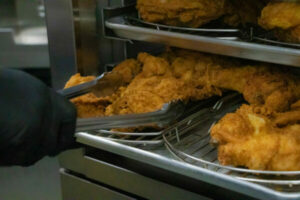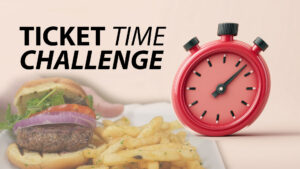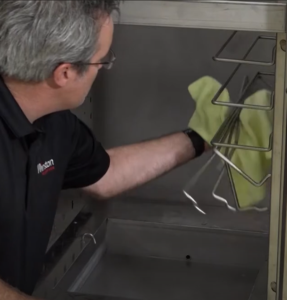
Keep it Hot, But Don’t Try to Cook
Warming cabinets are designed to maintain hot food at a specified temperature. But don’t let the name fool you. Food must already be hot before placing it in a warming cabinet. Although the cabinets are heated, operators should not use holding equipment for cooking or retherming. That’s a big no-no for health codes. You risk sickening your customers if you misuse holding equipment to heat food.
Don’t Overshoot the Holding Temperature
Warming cabinets are usually insulated to hold foods above the temperature danger zone for extended periods. Food products must be maintained at or above 141°F to ensure food safety. Some operators set the internal cabinet temperatures about ten degrees higher (or more) than the desired internal food temperature to compensate for door openings and normal heat loss. However, this hack isn’t necessary if the cabinet is well-designed.
For instance, CVap® warming cabinets utilize heated water vapor as the primary heat transfer medium. Water vapor is much more efficient at heat transfer than heated air. This helps CVap cabinets to recover temperature quickly, even with frequent door openings.
On the other hand, operators who try to compensate for inefficient cabinets by setting them at higher temperatures will find that this hack backfires and dries out food. The higher temperatures accelerate the loss of food quality.
Warming Cabinet Best Practices - Preheat, So It’ll Be Safe to Eat
It may seem obvious, but it’s important to preheat holding equipment, whether a cabinet or a drawer. Placing food in a unit that hasn’t preheated will allow the food temperature to drop quickly. Although the food may eventually warm back up, it may have slipped into the temperature danger zone. And rewarming in the warming cabinet isn’t what the cabinets are designed to do.
Humidified cabinets need a little extra time to preheat. They utilize water vapor as a thermal transfer medium. For example, CVap equipment holds about 2.5 gallons of water in its reservoir (or evaporator). That’s a sizeable mass to heat up. A good rule of thumb is to allow approximately 45 minutes for CVap units to preheat fully. This primes them to be ready to hold food at the proper temperature and texture.
Don’t Damage the Stainless
Most holding cabinets are built with stainless steel. Although stainless steel is tough, it doesn’t take kindly to abrasion. Once the surface of stainless steel has been damaged, the steel is subject to corrosion and rust. Don’t use abrasive cleaners or cleaning pads on stainless. Use mild food-grade cleaners and pads recommended by the manufacturer.
Keep Rolling, Carefully
Most warming cabinets are mounted on casters, making them easy to move. Keep an eye on the condition of the casters. Be aware of debris on the floor. A tiny bit of schmutz can cause a wheel to get stuck, making the cabinet harder to move or even tip over if it’s a tall cabinet moving at a good clip. Likewise, if a wheel develops a flat spot, it should be replaced.
When Good Warmers Go Bad
Following warming cabinet best practices is best for maintaining your equipment’s electrical systems. The majority of holding equipment is electrically powered. Should a unit act up, check the power cord to see if it is loose or frayed. If that doesn’t resolve the problem, contact the manufacturer’s customer service department for advice.
If a cabinet is not holding food at the proper temperature, faulty temperature sensors could be the culprit. Check the sensors for debris and clean them if needed. If that doesn’t resolve the problem, contact the manufacturer or a certified technician.
Some manufacturers use thermostats that need periodic calibration. CVap warmers, on the other hand, don’t utilize thermostats and never need calibration.
Misconceptions in Heated Holding
A common misconception is that food cooked to a higher internal temperature will hold longer. This isn’t true. Cooking food to a higher-than-necessary temperature means more moisture evaporates from the food. Moisture loss causes temperature fluctuations and reduces both holding time and food quality.
Of course, if you’re cooking in a CVap oven, moisture loss isn’t a concern. CVap technology allows the operator to dial in the desired food consistency, from crisp to moist.
Some holding cabinets instruct you to open vents to hold crisp foods longer. This isn’t necessary with CVap cabinets.

Unlike other technologies, CVap allows the operator to control food texture independent of food temperature. Let’s be honest; no food can be held indefinitely. And crisp foods like fried chicken will inherently have shorter hold times (compared to more moist foods). But CVap still offers a more extended quality hold than the competition.
Winston had culinary experts on hand to answer any questions about hot holding. Just fill out our Ask Winston form. We’re happy to help.





